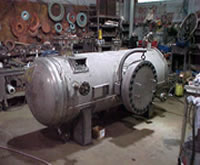Pressure Vessel
Introduction
A pressure vessel is a closed container designed to hold gases or liquids at a pressure substantially different from the ambient pressure. The pressure differential is dangerous and many fatal accidents have occurred in the history of pressure vessel development and operation. Consequently, pressure vessel design, manufacture, and operation are regulated by engineering authorities backed by legislation. For these reasons, the definition of a pressure vessel varies from country to country, but involves parameters such as maximum safe operating pressure and temperature. A common design is a cylinder with end caps called heads. Head shapes are frequently either hemispherical or dished . More complicated shapes have historically been much harder to analyze for safe operation and are usually far more difficult to construct. A disadvantage of these vessels is that greater breadths are more expensive.
Specifications of Pressure Vessel Heat Exchanger:
- Pressure Vessel Heat Exchanger has approximately twice the strength of a cylindrical pressure vessel.
- A spherical shape is difficult to manufacture, and therefore more expensive, Pressure vessels are cylindrical with semi-elliptical heads or end caps on each end. Smaller pressure vessels are assembled from a pipe and two covers.
Applications of Pressure Vessel Heat Exchanger:
- They appear in these sectors as industrial compressed air receivers and domestic hot water storage tanks and outdoor wood furnaces
- Pressure vessels are diving cylinders, recompression chambers, distillation towers, autoclaves, and many other vessels in mining operations.
Features of Pressure Vessel Heat Exchanger:
- Statutory requirements are provided for pressure vessels, reactors, columns and heat exchangers falling under specific Indian process and lethal chemical processing equipment.
- All material procured from reputed suppliers with test certificates to ascertain perfection of material as per client specification & code requirements for quality assurance.
- Customization available for various segments of Chemical, Pharmaceuticals, Petrochemical, Refineries, Paper and Pulp & various other segments of process industries.
- Plate bending facility up to 50 mm.
- Types of welding processed used SAW, SMAW, TIG & MIG
- Non-Destructive and destructive testing methods used to check if our quality of our pressure vessels, reactors, columns and heat exchangers
Advantages of Pressure Heat Exchanger:
- Pressure vessels can theoretically be almost any shape, but shapes made of sections of spheres, cylinders, and cones are usually employed.
- Pressure vessels are used in a variety of applications in both industry and the private sector.
Images:


